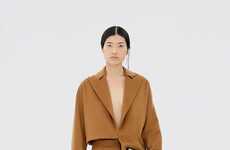
Designers Bring Back Post-Depression Luxury Fashion
Was the abundance of fur for Fall 2009 fashion collections an optimistic look toward the end of the recession? The furry stoles, shawls and hairy wraps were a flashback to the 1940s when wearing animal pelts was a chic sign of affluence—and a clear indicator one was free of the gloom and doom of the previous decade’s depression.
Could the return of fur for Fall 2009 be a sartorial reflection of our wish to escape the current global economic crisis? Or could this be a more subtle bridge off the European Furries craze in which people escape their human worries (like credit crunch anxiety) by dressing up as animals?
Designers who featured fur for Fall 2009 include Lavin, D&G (brown fur bolero seen in the gallery), Roberto Cavalli (furry gorilla arm sleeves), Derek Lam (asymmetrical brown fur collared coat), Donna Karan and Fendi who both featured fuzzy animal skin cuffs, Givenchy who chic-ed up the military look with a soft stole, Jean Paul Gaultier, and Ferragama and Giles Deacon, both of which featured the monkey arm look as well.
Could the return of fur for Fall 2009 be a sartorial reflection of our wish to escape the current global economic crisis? Or could this be a more subtle bridge off the European Furries craze in which people escape their human worries (like credit crunch anxiety) by dressing up as animals?
Designers who featured fur for Fall 2009 include Lavin, D&G (brown fur bolero seen in the gallery), Roberto Cavalli (furry gorilla arm sleeves), Derek Lam (asymmetrical brown fur collared coat), Donna Karan and Fendi who both featured fuzzy animal skin cuffs, Givenchy who chic-ed up the military look with a soft stole, Jean Paul Gaultier, and Ferragama and Giles Deacon, both of which featured the monkey arm look as well.
Trend Themes
1. Return of Fur Fashion - Opportunity for the fashion industry to capitalize on the growing demand for luxurious fur clothing and accessories.
2. Nostalgic 1940s Inspiration - An opportunity for designers to tap into the nostalgia of the 1940s fashion era and create retro-inspired collections.
3. Escapist Fashion Trends - Opportunity for fashion brands to cater to consumers seeking a means of escapism through clothing during times of economic uncertainty.
Industry Implications
1. Fashion - Fashion brands can adapt to the resurgence of fur fashion and cater to consumers' desire for luxury and nostalgia.
2. Textile and Animal Skin Industries - Opportunity for these industries to supply high-quality fur materials to meet the growing demand in the fashion market.
3. Retail - Retailers can capitalize on the popularity of fur fashion by offering a wide range of fur products to meet consumer demand.
2.8
Score
Popularity
Activity
Freshness























